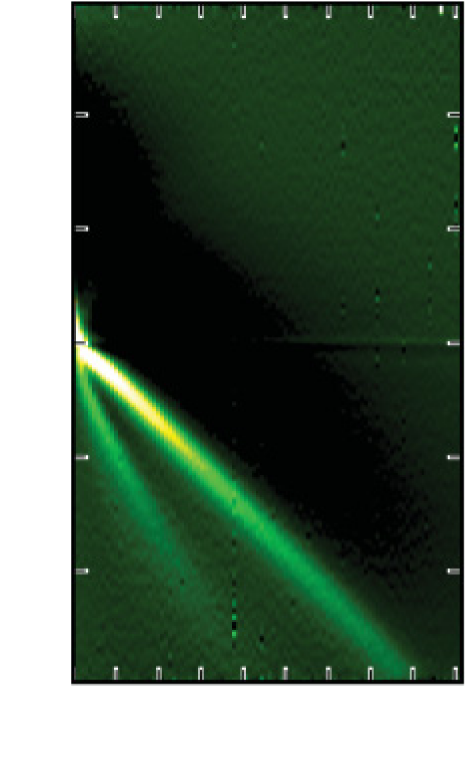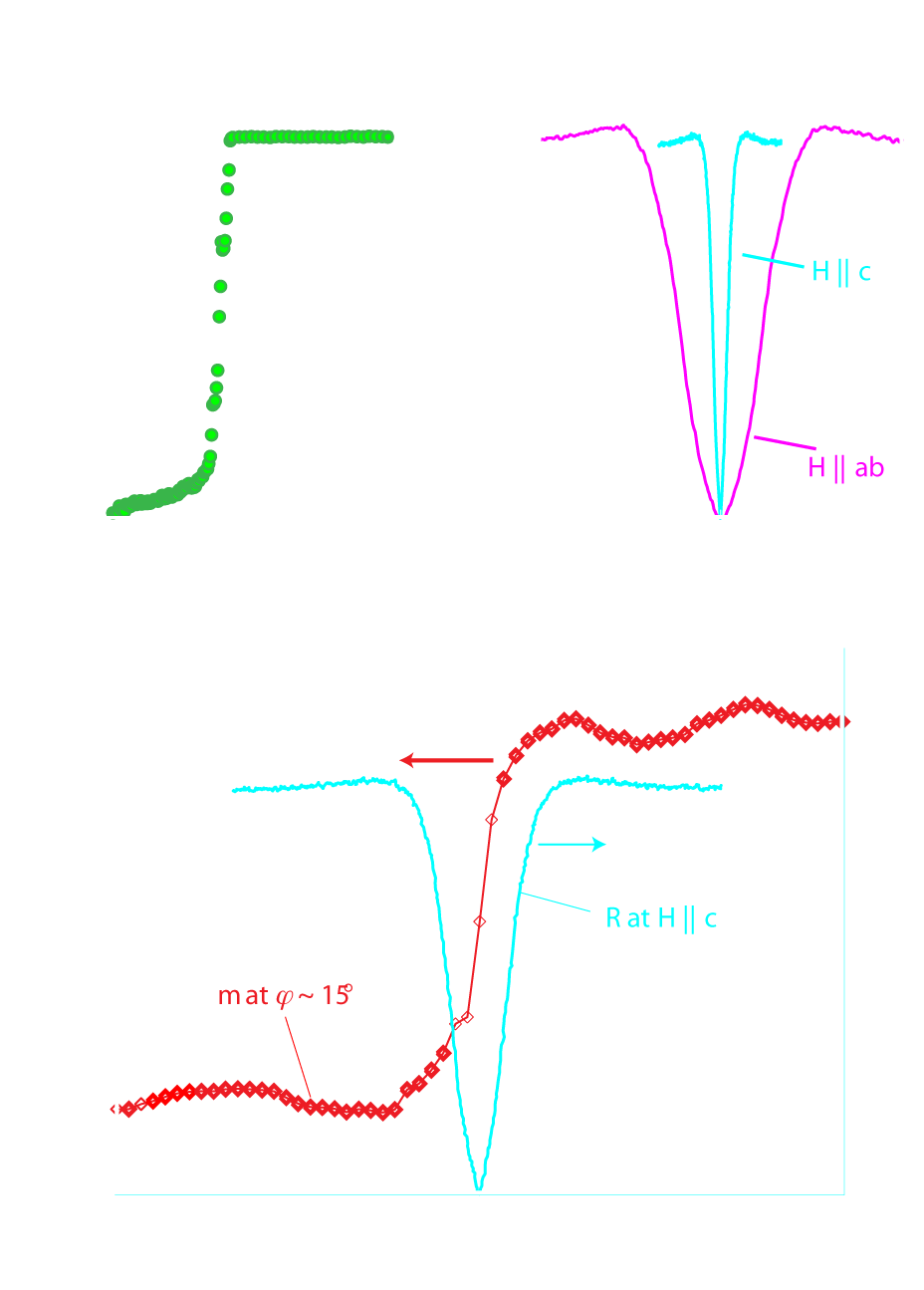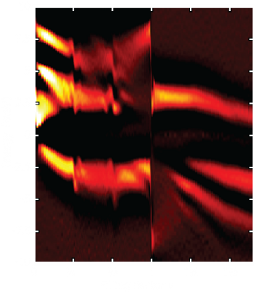Full Momentum and Energy Resolved Spectral Function of a 2D Electronic System

Published in Science 358, 6365 (2017). See also:MIT news
The single-particle spectral function measures the density of electronic states in a material a function of both momentum and energy, providing central insights into strongly correlated electron phenomena. Here we demonstrate a high-resolution method for measuring the full momentum-and energy-resolved electronic spectral function of a two-dimensional (2D) electronic system embedded in a semiconductor. The technique remains operational in the presence of large externally applied magnetic fields and functions even for electronic systems with zero electrical conductivity or with zero electron density. Using the technique on a prototypical 2D system, a GaAs quantum well, we uncover signatures of many-body effects involving electron-phonon interactions, plasmons, polarons, and a phonon analog of the vacuum Rabi splitting in atomic systems.
Sharp tunnelling resonance from the vibrations of an electronic Wigner crystal
Photoemission and tunnelling spectroscopies measure the energies at which single electrons can be added to or removed from an electronic system. Features observed in such spectra have revealed electrons coupling to vibrational modes of ions both in solids and in individual molecules3. Here we report the discovery of a sharp resonance in the tunnelling spectrum of a two-dimensional electron system. Its behaviour suggests that it originates from vibrational modes, not involving ionic motion, but instead arising from vibrations of spatial ordering of the electrons themselves. In a two-dimensional electronic system at very low temperatures and high magnetic fields, electrons can either condense into a variety of quantum Hall phases or arrange themselves into a highly ordered ‘Wigner’ crystal lattice. Such spatially ordered phases of electrons are often electrically insulating and delicate, and have proven very challenging to probe with conventional methods. Using a pulsed tunnelling method capable of probing electron tunnelling into insulating phases, we observe a sharp peak with dependencies on energy and other parameters that fit to models for vibrations of a Wigner crystal. The remarkable sharpness of the structure presents strong evidence of the existence of a Wigner crystal with long correlation length.
Published in Nature Physics, advance online publication DOI:10.1038/nphys3979
Congratulations to two postdocs in our group for their new positions!
Congratulations to two postdocs in our group on landing great faculty positions! Dr. Andrea Young will join the faculty of the UC Santa Barbara Physics Department in March 2014, and Dr. Ben Hunt will join the faculty of the Carnegie Mellon Physics Department in fall of 2015.
Tunable symmetry breaking and helical edge transport in a graphene quantum spin Hall state
Published in Nature 505 (23 Jan. 2014): Our new paper on the quantum spin Hall effect in graphene, in collaboration with the Jarillo-Herrero group: http://www.nature.com/nature/journal/vaop/ncurrent/full/nature12800.html (also available on the arXiv here)
Low-dimensional electronic systems have traditionally been obtained by electrostatically confining electrons, either in heterostructures or in intrinsically nanoscale materials such as single molecules, nanowires, and graphene. Recently, a new paradigm has emerged with the advent of symmetry-protected surface states on the boundary of topological insulators, enabling the creation of electronic systems with novel properties. For example, time reversal symmetry (TRS) endows the massless charge carriers on the surface of a three-dimensional topological insulator with helicity, locking the orientation of their spin relative to their momentum. Weakly breaking this symmetry generates a gap on the surface, resulting in charge carriers with finite effective mass and exotic spin textures. Analogous manipulations of the one-dimensional boundary states of a two-dimensional topological insulator are also possible, but have yet to be observed in the leading candidate materials. Here, we demonstrate experimentally that charge neutral monolayer graphene displays a new type of quantum spin Hall (QSH) effect, previously thought to exist only in TRS topological insulators, when it is subjected to a very large magnetic field angled with respect to the graphene plane. Unlike in the TRS case, the QSH presented here is protected by a spin-rotation symmetry that emerges as electron spins in a half-filled Landau level are polarized by the large in-plane magnetic field. The properties of the resulting helical edge states can be modulated by balancing the applied field against an intrinsic antiferromagnetic instability, which tends to spontaneously break the spin-rotation symmetry. In the resulting canted antiferromagnetic (CAF) state, we observe transport signatures of gapped edge states, which constitute a new kind of one-dimensional electronic system with tunable band gap and associated spin-texture.
Massive Dirac fermions and Hofstadter butterfly in a van der Waals heterostructure

Published June 21st in Science: our new paper on the behavior of graphene Dirac electrons in the presence of a moiré superlattice potential.
http://www.sciencemag.org/content/early/2013/05/15/science.1237240
See this nice perspective in the same issue from Michael Fuhrer.
Also, see MIT News for a nice description of the work.
Van der Waals heterostructures comprise a new class of artificial materials formed by stacking atomically-thin planar crystals. Here, we demonstrate band structure engineering of a van der Waals heterostructure composed of a monolayer graphene flake coupled to a rotationally-aligned hexagonal boron nitride substrate. The spatially-varying interlayer atomic registry results both in a local breaking of the carbon sublattice symmetry and a long-range moire’ superlattice potential in the graphene. This interplay between short- and long-wavelength effects results in a band structure described by isolated superlattice minibands and an unexpectedly large band gap at charge neutrality, both of which can be tuned by varying the interlayer alignment. Magnetocapacitance measurements reveal previously unobserved fractional quantum Hall states reflecting the massive Dirac dispersion that results from broken sublattice symmetry. At ultra-high fields, integer conductance plateaus are observed at non-integer filling factors due to the emergence of the Hofstadter butterfly in a symmetry-broken Landau level.
We received a $1.7 Million grant from the Moore Foundation to further our Time Domain Capacitance Spectroscopy work!
This MIT News article describes it in detail.
Observations of plasmarons in a two-dimensional system: Tunneling measurements using time-domain capacitance spectroscopy
“Observations of plasmarons in a two-dimensional system: Tunneling measurements using time-domain capacitance spectroscopy”, Phys. Rev. B85, 081306(R) (2012)
Calculations of the single-particle density of states (SPDOS) of electron liquids have long predicted that there exist two distinct charged excitations: the usual quasiparticle consisting of an electron or hole, and a plasmaron consisting of a hole resonantly bound to real plasmons in the Fermi sea. Using tunneling spectroscopy to measure the SPDOS of a 2D electronic system, we demonstrate the detection of a plasmaron in a 2D system in which electrons have mass. With the application of a magnetic field we discover unpredicted magnetoplasmarons which resemble Landau levels with a negative index.
Two bright features (they look like green diagonal lines) appear in the figure on the right. The upper feature corresponds to the band-edge of a 2D electron system. The lower feature exists below the band-edge, and this feature is the long elusive “plasmaron”.
Coexistence of magnetic order and two-dimensional superconductivity at LAO/STO interfaces
"Coexistence of magnetic order and two-dimensional superconductivity at LaAlO3/SrTiO3 interfaces", Nature Physics 7, 762–766 (04 September 2011).
Combining high-resolution magnetic torque magnetometry and transport measurements, we report here magnetization measurements providing direct evidence of magnetic ordering of the two-dimensional electron liquid at the LAO/STO interface. The magnetic ordering exists from well below the superconducting transition to up to 200 K, and is characterized by an in-plane magnetic moment. Surprisingly, despite the presence of this magnetic ordering, the interface superconducts below 120 mK. This is unusual because conventional superconductivity rarely exists in magnetically ordered metals. Our results suggest that there is either phase separation or coexistence between magnetic and superconducting states. The coexistence scenario would point to an unconventional superconducting phase as the ground state.
See also: Nature Physics News and Views by A. J. Millis
Very Large Capacitance Enhancement in a Two-Dimensional Electron System
"Very Large Capacitance Enhancement in a Two-Dimensional Electron System", Science 323, 825-828 (13 May 2011)
Increases in the gate capacitance of field-effect transistor structures allow the production of lower-power devices that are compatible with higher clock rates, driving the race for developing high-κ dielectrics. However, many-body effects in an electronic system can also enhance capacitance. Onto the electron system that forms at the LaAlO3/SrTiO3 interface, we fabricated top-gate electrodes that can fully deplete the interface of all mobile electrons. Near depletion, we found a greater than 40% enhancement of the gate capacitance. Using an electric-field penetration measurement method, we show that this capacitance originates from a negative compressibility of the interface electron system. Capacitance enhancement exists at room temperature and arises at low electron densities, in which disorder is strong and the in-plane conductance is much smaller than the quantum conductance.
See also: MITnews, May 13th 2011
Anomalous structure in the single particle spectrum of the fractional quantum Hall effect
The single particle spectrum of a system reveals the energies of its quasiparticles; charged, long lived excitations. We measure the single particle spectrum of a 2D electron gas in the fractional quantum Hall regime. Despite the intensive study this system has received in the past, the structure of this spectrum is completely unexpected; the features we previously observed in the quantum Hall effect break up into a series of sharp features that disperse linearly in energy with density.
For an overview of the technique, you should look at our recent work, or Oliver’s PhD thesis.
Groundbreaking New Quantum Well Designs
A new wafer with a wider quantum well than we’ve used previously has begun providing fantastic new data. Single atom fluctuations in the width of the quantum well broaden TDCS features in energy. With the wider quantum well, these width variations are less important. The new spectra reveal quantum Hall physics in astounding detail, as shown in the data taken at 1 Tesla above (compare with that in our recent Nature paper. At higher fields, we are beginning to understand how the fractional quantum Hall effect reveals itself in the single particle spectrum, while at lower fields we’re pinning down the properties of a previously unobserved coupled electron-plasmon excitation.
Tunneling Spectroscopy in the News
Our recent TDCS work (below) has been well received. Charles Day, with Physics Today, produced an excellent writeup in “Search and Discovery”. This made the cover of their Japanese affiliate Parity (as shown to the right).
Anne Trafton at MIT’s press office also produced an extraordinarily understandable summary, including photos of the new dilution refrigerator we’re moving the experiment into. A shorter version of this appeared in MIT’s Tech Talk.
“High-resolution spectroscopy of two-dimensional electron systems”, Nature 448, 176-179 (12 July 2007).
By probing the single-particle spectrum of a two-dimensional electron gas, we reveal the intricate and beautiful energy structure far from the Fermi surface. The measured spectra show a host of different physical phenomena, making them a fantastic resource for understanding these complex systems.
For an overview, you should look at this press release. For more information, have a look at our capacitance spectroscopy page, Oliver’s simulations page, or his home page
“Imaging Transport Resonances in the Quantum Hall Effect”, Physical Review Letters 95 136804 (2005)
 "Imaging Transport Resonances in the Quantum Hall Effect”, Physical Review Letters 95 136804 (2005)
"Imaging Transport Resonances in the Quantum Hall Effect”, Physical Review Letters 95 136804 (2005)
People have long understood that localization plays a fundamental role in the quantum Hall effect. However, the microscopic nature of the localized states is inaccessible to bulk transport measurments: what these localized states actually are is still a mystery. In our work, we use a charge-sensitive scanning probe to measure the transport properties of localized states in the quantum Hall effect on a microscopic scale.
To learn more, have a look at our SPM Imaging page, or Gary Steele’s thesis.
Gary's thesis is quite large; if you have a slow connection, you might look at this version with compressed images.






